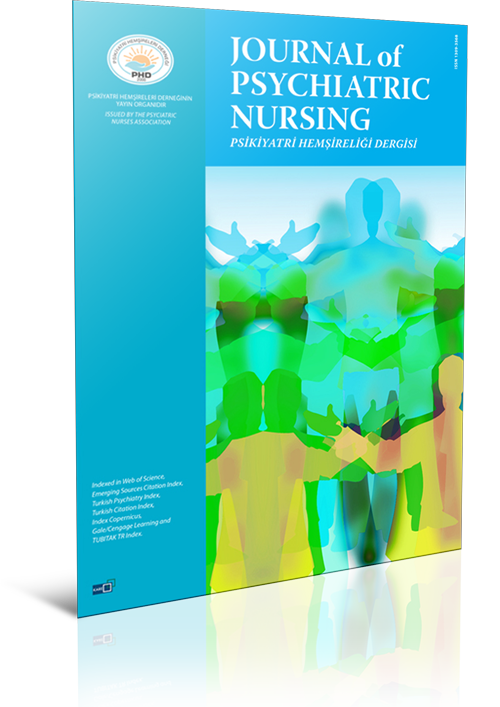
Volume: 16 Issue: 1 - 2025
| FRONTMATTER | |
| 1. | Front Matter Pages I - IV |
| EDITORIAL | |
| 2. | Editorial Fahriye Oflaz Page V |
| RESEARCH ARTICLE | |
| 3. | The relationship between emotional intelligence and burnout among mental health nurses in Morocco Jamal Ksiksou doi: 10.14744/phd.2025.91129 Pages 1 - 9 INTRODUCTION: This descriptive and correlational study was conducted to investigate the relationship between emotional intelligence (EI) levels and burnout in mental health nurses. METHODS: The study sample comprised 112 nurses from three psychiatric hospitals in the Tangier-Tetouan-Al Hoceima regional health authority. Data were collected using the Personal Information Questionnaire, the Wong and Law EI Scale, and the Maslach Burnout Inventory. Data were analyzed using Students t-test, Kruskal Wallis test, Pearsons correlation, and linear regression analysis. RESULTS: The nurses mean EI score was 27.61±6.5, while the mean burnout score was 24.06±7.3. A significant negative relationship was observed between burnout and EI scores (r=−0.352; p<0.05). In addition, a statistically significant difference was observed between demographic characteristics, including gender and marital status, and EI and burnout scores (p<0.05). Multiple regression analysis showed that three factors statistically significantly predicted burnout in nurses in the final regression model. These were gender (β=0.466, p<0.05) and marital status (β=0.386, p<0.05). However, total EI score was a significant negative predictor (β=−0.454, p<0.05). DISCUSSION AND CONCLUSION: EI has a strong influence on burnout. EI training programs should, therefore, be implemented to prevent and reduce the risk of burnout among mental health nurses. |
| 4. | Investigation of pre-operative ruminative thought styles and related factors in patients receiving inpatient treatment in the otorhinolaryngology clinic İlkay Demir, Reyhan Eskiyurt, Yavuz Fuat Yılmaz doi: 10.14744/phd.2025.88785 Pages 10 - 18 INTRODUCTION: The aim of this study was to investigate the relationship between pre-operative ruminative thought style and anxiety level and sleep quality in patients receiving inpatient treatment in the Otorhinolaryngology Clinic. METHODS: The descriptive, cross-sectional, and correlational study was conducted between May 01 and October 01, 2024, in the otolaryngology clinic of a public hospital. Sociodemographic data form, ruminative thinking style questionnaire (RTSQ), Beck Anxiety Inventory (BAI), and Richard-Campbell Sleep Questionnaire (RCSQ) were administered to the participants. RESULTS: The mean age of the patients who participated in our study was 40.75±16.26 years. The mean score of the RTSQ was 77.234±1.40, the mean score of BAI was 12.424±0.61 and the mean score of the RCSQ was 52.104±1.44. RTSQ was found to have a positive relationship with the BAI (r=0.434, p<0.05) and a negative relationship with RCSQ (r=−0.201, p<0.05). A negative relationship was found between the BAI and RCSQ (r=−0.304, p<0.05). Among the patients who had negative thoughts about the surgery, 14.7% stated statements related to fear of death. DISCUSSION AND CONCLUSION: This study revealed that as ruminative thinking increased, anxiety levels increased and sleep quality decreased in pre-operative patients in a surgical clinic. Future studies can be planned on the effect of rumination on the recovery process, demand for medical treatment for pain, and length of hospitalization of patients hospitalized in a surgical clinic. |
| 5. | Determination of the relationship between alexithymia, spiritual well-being, and quality of life in patients with coronary artery disease Ayşe Gül Parlak, Yeliz Akkuş, Gönül Gökçay doi: 10.14744/phd.2025.57984 Pages 19 - 29 INTRODUCTION: In this research, it was aimed to determine the predictors of quality of life (QoL) in coronary artery disease patients. METHODS: This descriptive and cross-sectional research was carried out with 345 coronary artery disease patients in the cardiology clinic of a university hospital. The data were collected by using the Patient Information Form, Toronto alexithymia scale-20 (TAS-20), Spiritual Well-being Scale (SWBS), and heart QoL scale (HeartQoL). RESULTS: The mean age of the patients was 60.71±11.88 years in this study. The average total scores of the scales were TAS-20 56.81±14.81, SWBS 109.35±19.44, and HeartQol 1.46±0.69, respectively. HeartQol was predicted by the number of children (β=−0.672), occupation (β=9.154), social security (β=5.957), following diet program regularly (β=3.452), regular walking (β=2.981), and TAS-20 (β=−0.184). DISCUSSION AND CONCLUSION: The presence of alexithymia in coronary artery disease patients might affect the QoL adversely. Within the extent of holistic care, it is of great importance for nurses to diagnose alexithymic patients and to plan supportive interventions for this patient group for improve QoL. |
| 6. | Anxiety and death anxiety in individuals who were admitted to the emergency department with suspicion of COVID-19 in decreased pandemic period Emre Bulut, Işıl Işık Andsoy doi: 10.14744/phd.2025.64624 Pages 30 - 37 INTRODUCTION: COVID-19 led to pandemic-related anxiety and death anxiety among Turkish people, and these might continue during the decreased period of the pandemic. There is a lack of studies that are focused on the fear and anxiety of death in individuals during the period when the effects of the pandemic have decreased. This study aimed to investigate COVID-19 anxiety and death anxiety in individuals who were admitted to the emergency department (ED) with suspicion of infection. METHODS: This descriptive cross-sectional study was conducted with 350 individuals between 25 January and 25 April 2022. The research data were collected using the Personal Information Form, the Coronavirus Anxiety Scale (CAS), and the Templer Death Anxiety Scale (DAS). RESULTS: The CAS score was 0.90±2.23, and the DAS score was 7.72±3.22. The CAS of participants was low, whereas the DAS was moderate. Participants who were women, who had psychiatric problems, and who witnessed death from COVID-19 had higher CAS scores (p<0.05). Similarly, women, who had psychiatric problems, who had COVID-19 infection before, and who heard of a death diagnosed with COVID-19 had higher DAS scores (p<0.05). There was a positive correlation between the CAS scores and their DAS scores (r=0.190; p≤0.001). DISCUSSION AND CONCLUSION: This study showed that there was still low COVID-19 anxiety and moderate death anxiety among individuals who were admitted to the ED with suspicion of infection. Knowledge about coronavirus anxiety and death anxiety may assist in providing support to high-risk individuals, especially women, and individuals with psychiatric problems in the emergency units. |
| 7. | Examination of depression, anxiety, and stress in nursing students receiving distance education during the COVID-19 pandemic Şirin Harkın Gemicioğlu, Münevver Sönmez, Gaye Kara, Betül Bozer, Öznur Güder, Iclal Oztürk doi: 10.14744/phd.2025.26566 Pages 38 - 47 INTRODUCTION: This study aimed to examine depression, anxiety, and stress among nursing students (NSs) receiving distance education during the COVID-19 pandemic. METHODS: This descriptive and cross-sectional study was conducted with 583 NSs who received remote education during Covid-19 at a public university in the 20202021 academic year. Study data were collected online using the Personal Information Form and depression anxiety stress scale short form-21. RESULTS: According to the study results, the mean depression score of NSs was 9.11±5.14, the mean anxiety score was 6.21±4.18, and the mean stress score was 8.66±4.63. The study found that female students had higher levels of stress (p=0.002), anxiety (p=0.043), and depression (p=0.020) compared to male students. Third-year students exhibited significantly higher levels of stress (p=0.015) and anxiety (p<0.001) than students in other academic years. Students who experienced a decrease in income reported higher stress levels compared to those who did not (p=0.006). Students with a device exhibited higher levels of stress, anxiety, and depression than those without a device. The mean scores of depression, anxiety, and stress of students with sleep problems were higher than those of students without sleep problems. DISCUSSION AND CONCLUSION: During the COVID-19 pandemic, NSs receiving distance education were found to have high levels of depression, anxiety, and stress. Providing internet and technological device support for NSs in future distance education implementations in Türkiye and conducting various studies to harmonize nursing education with distance education are recommended. |
| QUALITATIVE RESEARCH | |
| 8. | Experiences related to grief and death from the perspective of nurses caring for individuals approaching the end of life: A qualitative study Yeliz Yelen Akpınar, Çiğdem Fulya Dönmez, Nesrin Aştı doi: 10.14744/phd.2025.53911 Pages 48 - 59 INTRODUCTION: It is known that it is important to determine the needs of individuals and their life experiences to improve the quality of respected care for individuals with life-threatening illnesses. This qualitative study aimed to identify ex-periences related to grief and death from the perspective of nurses caring for individuals approaching the end of life. METHODS: This study is based on a qualitative research design. The sample of the study consisted of 15 nurses working in the palliative care and intensive care clinics of a training and research hospital in the Central Anatolia Region, caring for terminally ill individuals. The findings of the study were collected through semi-structured, in-depth individual interviews with audio recordings. The findings were analyzed thematically using the N-Vivo12 program. RESULTS: The average age of the nurses who participated in this study was 35 years. As a result of this study, four main themes and 13 subthemes emerged. Main theme I: End-of-life care needs (Subthemes: Support systems, preference for place of death, information, and spiritual needs); Main theme II: Reactions to death (Subthemes: Denial, anger, blame, and acceptance); Main theme III: Difficulties experienced in nursing care (Subthemes: Continuous requesting individual, difficulties in talking about death, and difficulties created by the nurses death anxiety); Main theme IV: Facilitators in nursing care (Subthemes: Therapeutic communication and acceptance of death). DISCUSSION AND CONCLUSION: This qualitative study is thought to contribute to nurses understanding of grief and bereavement experiences so that individuals can receive dignified and quality care at the end of life. |
| SYSTEMATIC REVIEW | |
| 9. | Self-concept problem and inpatient with breast cancer: A scoping review Ni Made Merlin, Ibrahim Rahmat, Wiwin Lismidiati, Israfil Israfil doi: 10.14744/phd.2025.78989 Pages 60 - 66 INTRODUCTION: This research aims to find out more deeply about the problems that occur in the self-concept of breast cancer patients. METHODS: This scoping review uses guidelines from Arksey and OMalley. Various databases were used in this search, including Scopus, Medline through EBSCO, ProQuest, Springer Link, and PubMed, to look at self-concept problems in breast cancer patients, published from 2018 to 2024, with the criteria: primary study research that discusses the components of self-concept cancer patients undergoing treatment in hospital. The data included in this scoping review is described using frequencies and percentages. RESULTS: There are 16 articles analyzed, quantitative research (87.6%), qualitative (6.2%), and mixed-method (6.2%). Research about self-esteem (12.5%), body image (43.7%), self-role (6.2%), self-identity (6.2%), self-ideal (6.2%), and mixed (25%). DISCUSSION AND CONCLUSION: Thus, it can be concluded that the problems experienced by breast cancer patients during treatment can change due to several things, including changes in role, high self-ideals to fulfill their role as a woman, mother, or wife, and changing body shape. |
| REVIEW | |
| 10. | Digital dementia: The mental destruction of technology addiction Yalçın Kanbay, Aydan Akkurt Yalçıntürk, Elçin Babaoğlu, Aysun Akçam doi: 10.14744/phd.2025.53179 Pages 67 - 72 The concept of digital dementia provides important findings that excessive use of digital devices leads to impairments in cognitive functions. Factors such as early digital device use, digital amnesia, excessive screen exposure, digital addictions, and multitasking habits increase the risk of digital dementia. Increased screen time and digital device use lead to negative effects on brain structure and function, learning and memory, sleep patterns, attention and concentration, social isolation, emotional regulation, and mental health. The use of digital devices may adversely affect learning and memory processes, leading to a decrease in memory functions. Blue light decreases sleep quality by suppressing melatonin production. Continuous digital stimuli shorten attention and concentration periods, and social media use increases social isolation. Intensive use of digital devices may negatively affect emotional regulation and lead to mental health problems and substance use disorders. These findings emphasize the need for careful regulation of digital device use and the importance of limitations, especially for children and young people. In conclusion, digital dementia is a cognitive impairment caused by excessive use of digital devices, which is a consequence of the modern age. Prevention of this condition is possible by individuals limiting their use of digital media and developing healthy living habits. Further research and awareness studies will help us understand the effects of digital dementia and develop strategies to prevent this condition. |


















